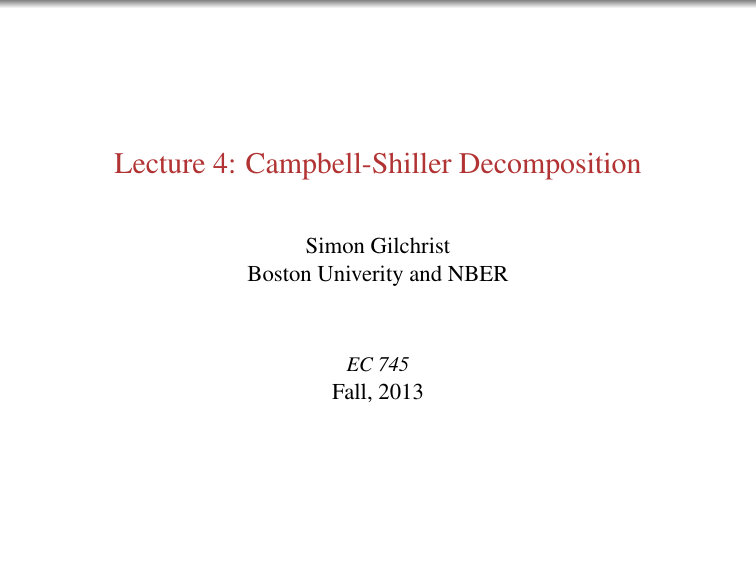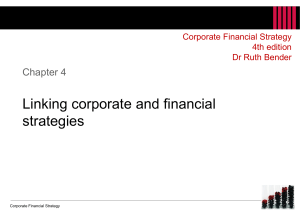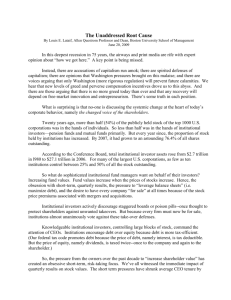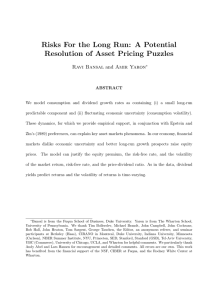Lecture 4: Campbell-Shiller Decomposition Simon Gilchrist Boston Univerity and NBER Fall, 2013
advertisement

Lecture 4: Campbell-Shiller Decomposition Simon Gilchrist Boston Univerity and NBER EC 745 Fall, 2013 Campbell and Shiller decomposition Introduce a log-linear approximation to the present-value identity (prices = Present Discounted Value [PDV] of dividends). Use this approximation to discuss the sources of stock price volatility. This formula has proven extremely useful in applied work, because it is easy to use it in conjunction with linear time series models (e.g. VARs). Also known as “Discount Rate - Cash Flow Decompositions” Present Discounted Values Start from the definition of return: Pt+1 + Dt+1 . Rt+1 = Pt Rewrite this as “price equal PDV of dividends” by rewriting and iterating forward: Dt+1 + Pt+1 Rt+1 Dt+1 Dt+2 = + + .... Rt+1 Rt+1 Rt+2 ∞ X Dt+k = , Rt,t+k Pt = k=1 where Rt,t+k is the realized return on the asset (not the risk-free rate!!!) from t to t + k : Rt,t+k = Rt+1 × ... × Rt+k . Log Returns. Use lowercase letters for logs: rt = log (1 + Rt ) , pt = log(Pt ), dt = log (Dt ) : Compute log-return as: rt+1 = log (Pt+1 + Dt+1 ) − log(Pt ) Dt+1 − pt = pt+1 + log 1 + Pt+1 = pt+1 − pt + log (1 + exp (dt+1 − pt+1 )) Approximation Do a first-order Taylor approximation to the function f (x) = log (1 + exp(x)) around x = d − p where a denotes the sample average value: log (1 + exp (dt+1 − pt+1 )) ' k + (1 − ρ) (dt+1 − pt+1 ) , with: 1 1 + exp d − p k = − log ρ + (1 − ρ) log(1/ρ − 1). ρ = This yields: rt+1 = ρpt+1 − pt + k + (1 − ρ)dt+1 , pt = ρpt+1 + k + (1 − ρ)dt+1 − rt+1 . PDV Iterating forward yields: pt = X k + ρj−1 ((1 − ρ) dt+j − rt+j ) , 1−ρ j≥1 = X k + ρj ((1 − ρ) dt+1+j − rt+1+j ) . 1−ρ j≥0 This identity holds for any returns, prices and dividends ex-post. (And thus ex-ante, if you take conditional expectations of this equation.) It is an accounting identity without any behavorial assumption. Price-Dividend Ratio: From the log-linearized return equation we have: pt − dt = ρ(pt+1 − dt+1 ) + k + ∆dt+1 − rt+1 . Iterating forward: pt − dt = X k + ρj (∆dt+1+j − rt+1+j ) 1−ρ j≥0 Variation in the price-dividend ratio occurs because of variation in dividend growth or discount factors. Return innovations Start with the return equation rt+1 = ρpt+1 − pt + k + (1 − ρ)dt+1 , Now apply apply Et+1 − Et to both sides: rt+1 − Et rt+1 = ρ (pt+1 − Et pt+1 ) + (1 − ρ) (dt+1 − Et dt+1 ) From the price-dividend expression pt+1 − Et pt+1 = (Et+1 − Et ) X ρj (∆dt+2+j − rt+2+j ) j≥0 + dt+1 − Et dt+1 which implies: rt+1 − Et rt+1 = ρ (Et+1 − Et ) X j≥0 + (dt+1 − Et dt+1 ) ρj (∆dt+2+j − rt+2+j ) Return innovations We then have the expression rt+1 − Et rt+1 = (Et+1 − Et ) X − (Et+1 − Et ) X ρs ∆dt+1+s s≥0 ρs rt+1+s . s≥1 An unexpectedly good stock return must occur because either the current dividend went up, or expectations of future dividends go up, or because expectations of future returns go down. The first two terms are a standard “cash flow effect” and the second is an expected return or risk premium effect: the price goes up if the risk premium or risk-free interest rate go down. VAR model Hence, stock price volatility can come from either volatility of future dividends or volatility of expected future returns. Which of these terms contribute more to volatility empirically? Fit a VAR to dividend growth and returns and use the VAR to compute the implied decomposition: d ∆dt+1 ∆dt εt+1 rt+1 = A(L) rt + εrt+1 , xt+1 xt εxt+1 Iterating on this VAR one can compute the forecast Et ∆dt+1+j and then the revision of the forecast. Companion form: Let yt = (∆dt+1 , rt+1 , xt+1 )0 and define the 3px1 vector: zt = [yt ..yt−p ]0 Then zt follows an AR1 process: zt+1 = Azt + νt+1 with νt = ε0t 0..0 , Eεt ε0t = Σ. Present values with companion form: The expected PDV can be computed as: X X Et β j zt+j = β j Aj zt = (I − βA)−1 zt j≥0 j≥0 Premultiplying by the correct row vector to obtain the forecast of the PV of a component of z. Innovations to PDV Using this PDV we have X (Et+1 − Et ) β j zt+j = zt + β(I − βA)−1 zt+1 − (I − βA)−1 zt j≥0 = zt + β(I − βA)−1 (Azt + εt+1 ) − (I − βA)−1 zt The terms involving zt cancel so that X (Et+1 − Et ) β j zt+j = β(I − βA)−1 εt+1 . j≥0 Results Dividends are difficult to predict but returns are predictable as we saw before. This implies that changes in discount rates account for all of the volatility of revisions to returns. Since the risk-free interest rate does not move much in the data, it means the changes in expected returns are mainly changes in risk premia. Implication – we need to study models with time-varying risk premia Campbell-Cochrane, which has time-varying risk aversion. Stochastic volatility in consumption growth which leads to higher risk aversion when consumption volatility is high vs low. A Simple Model of Predictability: Stochastic processes: xt = bxt−1 + δt rt+1 = xt + εrt+1 ∆dt+1 = εdt+1 Model Solution: Price-dividend ratio: dt − pt = Et ∞ X ρj−1 (rt+j − dt+j ) = j=1 Returns: Rt+1 xt 1 − ρb Pt+1 Dt+1 /Dt = 1+ Dt+1 Pt /Dt Log-linearization: rt+1 = ρ (pt+1 − dt+1 ) + ∆dt+1 − (pt − dt ) Prices: ∆pt+1 = − (dt+1 − pt+1 ) + (dt − pt ) + ∆dt+1 VAR representation: 1 δt+1 1 − ρb ρ d = (1 − ρb) (dt − pt ) + εt+1 − δt+1 1 − ρb ρ d = (1 − b) (dt − pt ) + εt+1 − δt+1 1 − ρb dt+1 − pt+1 = b (dt − pt ) + rt+1 ∆pt+1 Implications for volatility: Assume ρ = 0.96 then estimated coefficient of returns on dividend price ratio is 1 − ρb where b is autocorrelation of returns. This implies b = 0.9. Assume D/P = 0.04. Returns as a function of levels: rt+1 = 1 − ρb Dt + εrt+1 D/P Pt If b = 0, a 1% rise in the D/P ratio implies that returns must rise 25%. If b = 0.9 then 1 − b = 0.1 and 1 − ρb = 0.14 and a 1% rise in D/P implies prices and returns rise by 2.5 and 3.4% respectively. If b = 0.96 then a 1% rise in D/P implies prices and returns rise by 1% and 2% respectively. (This seems like upper-bound on persistence). Result: iid dividend growth and persistent price-dividend ratio implies returns must respond more than one for one to the dividend-price change. Volatility Also 1 σ (x) 1 − ρb = 7.4σ (x) σ (d − p) = Dividend-price ratio should be much more volatile than returns. Persistence in returns implies that small variation in returns can have a large effect on the dividend-price ratio – similar to Gordon growth formula P = D r−g








![[These nine clues] are noteworthy not so much because they foretell](http://s3.studylib.net/store/data/007474937_1-e53aa8c533cc905a5dc2eeb5aef2d7bb-300x300.png)
